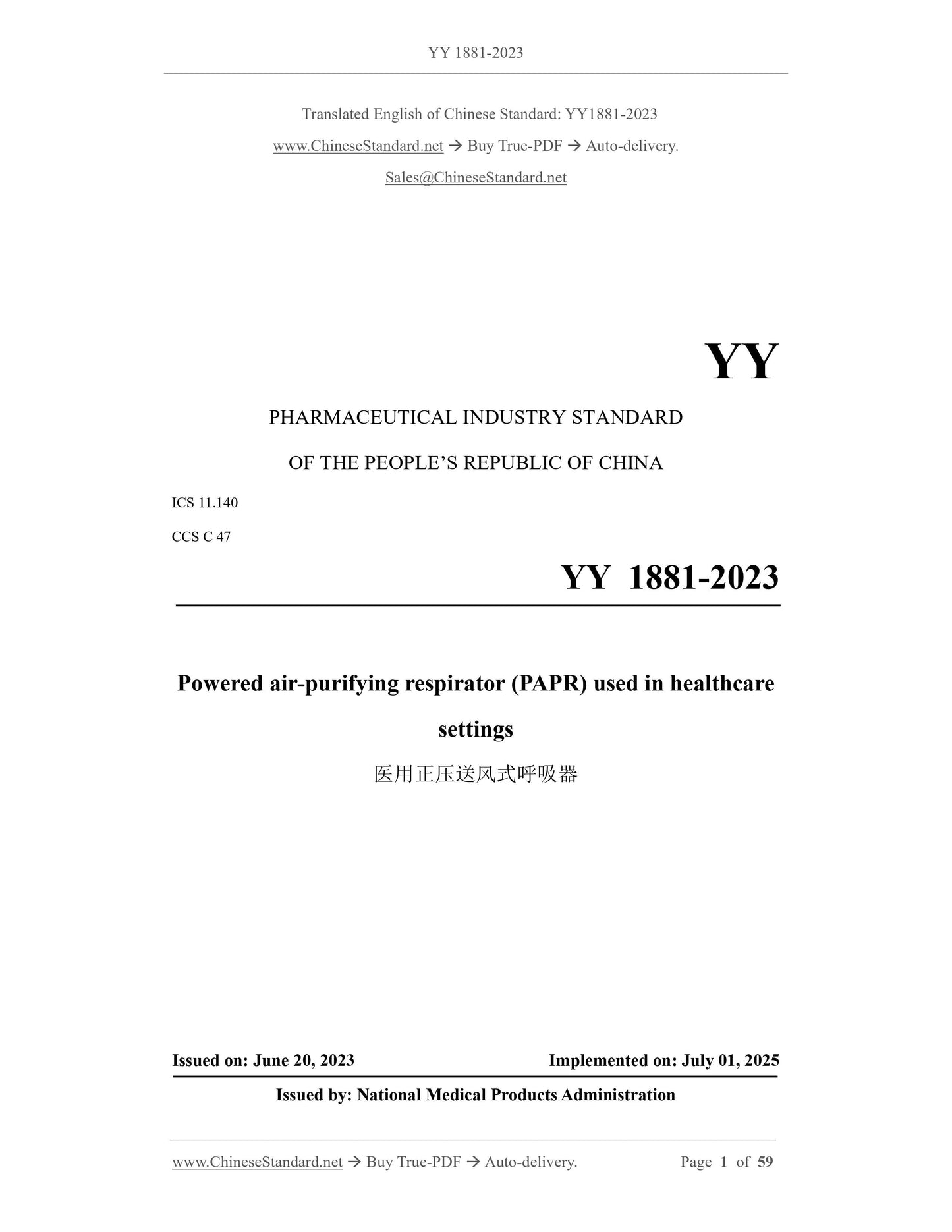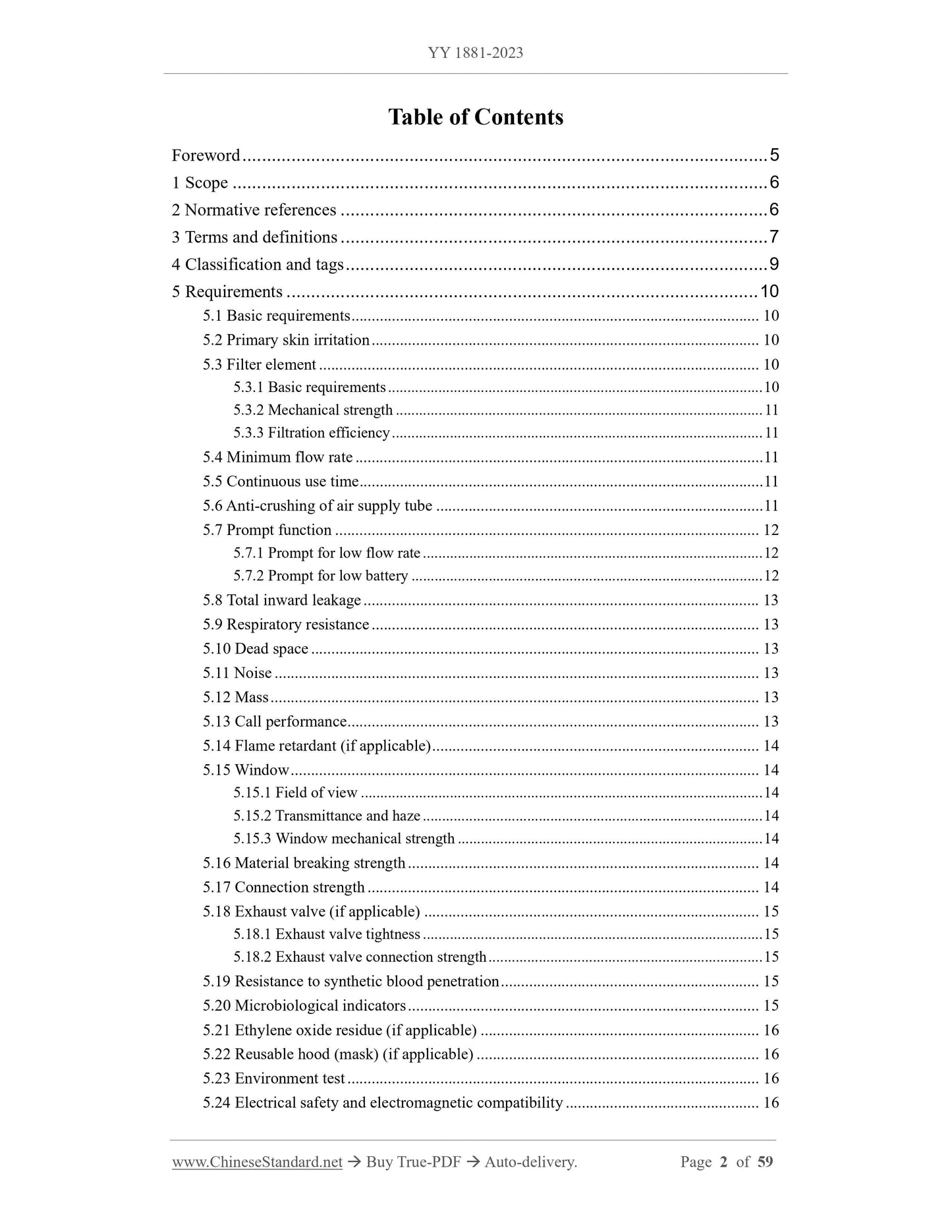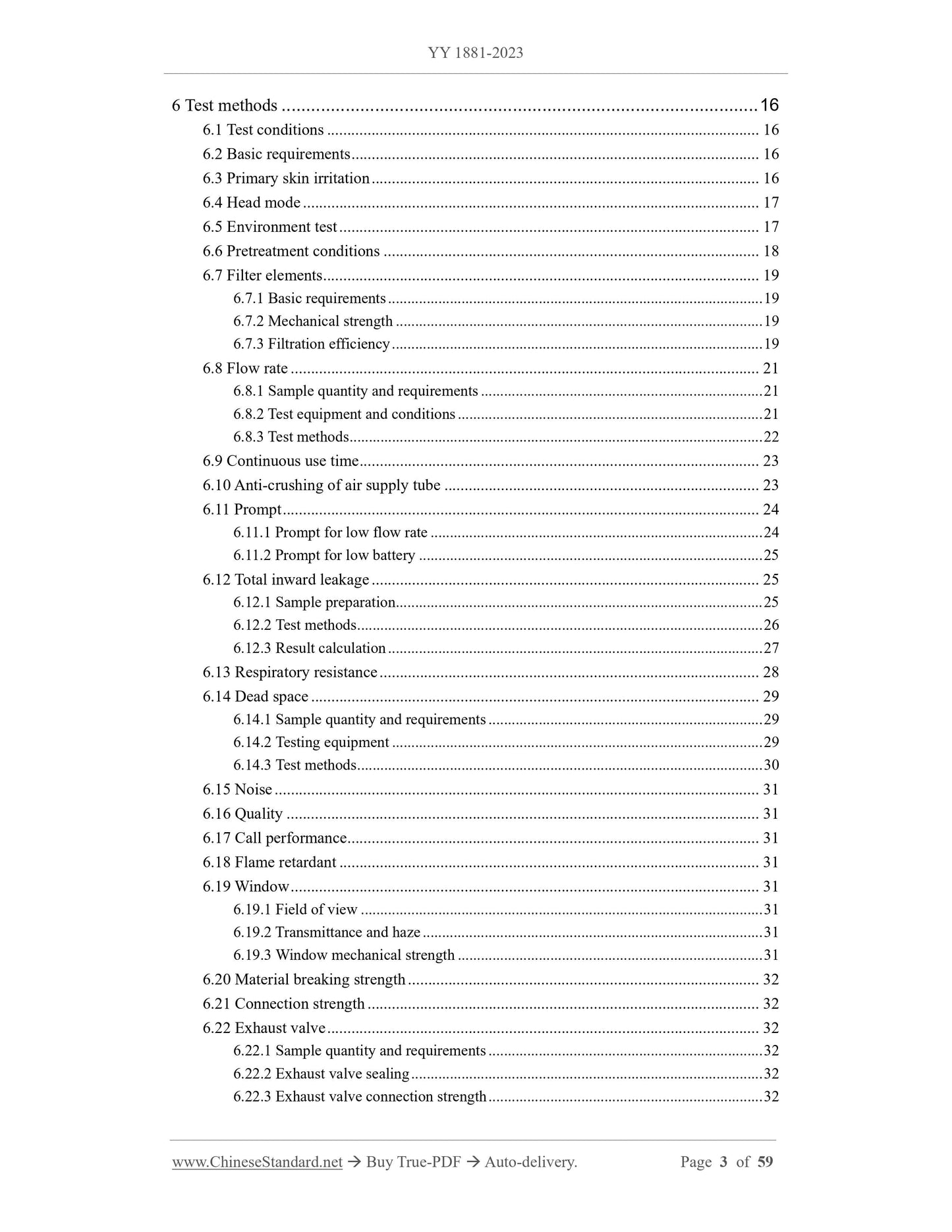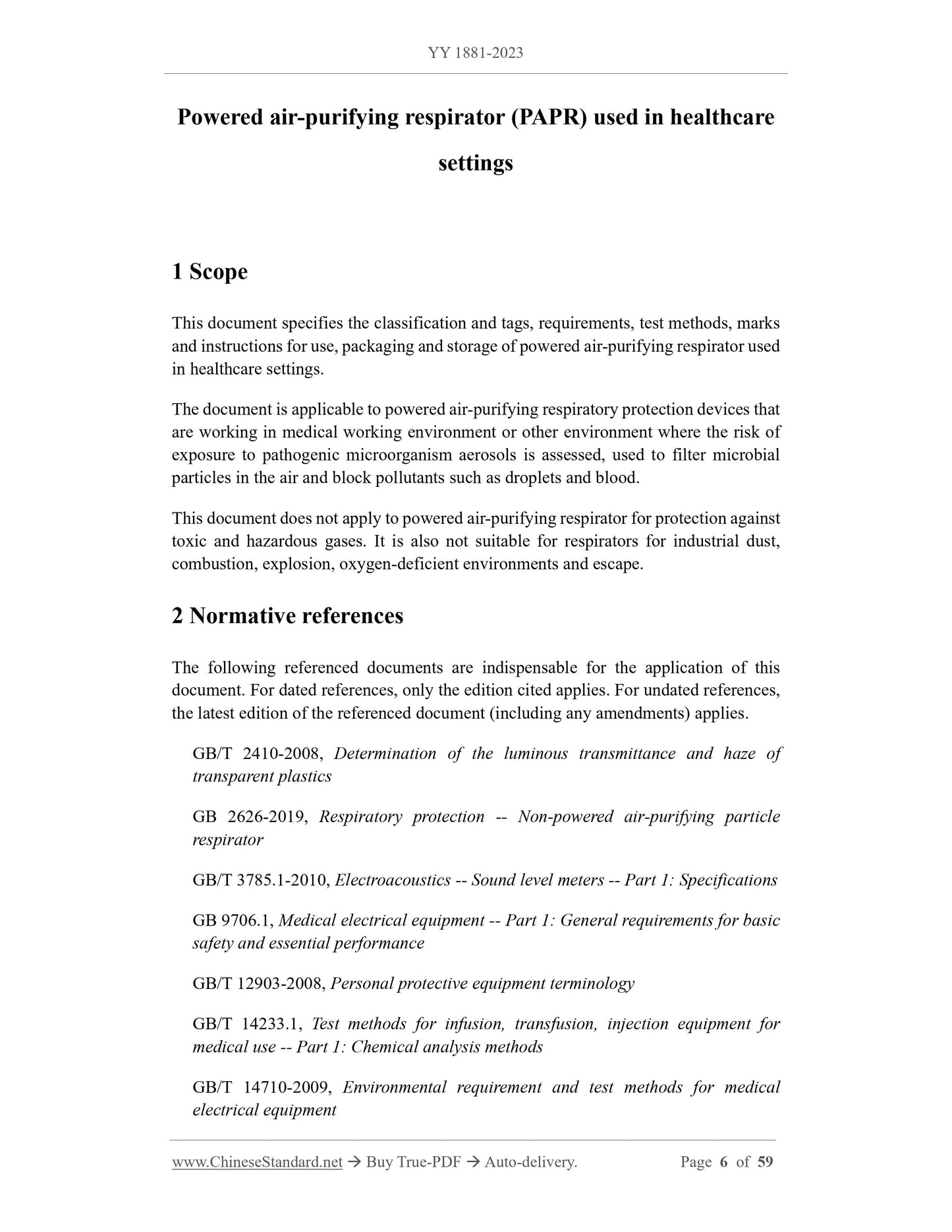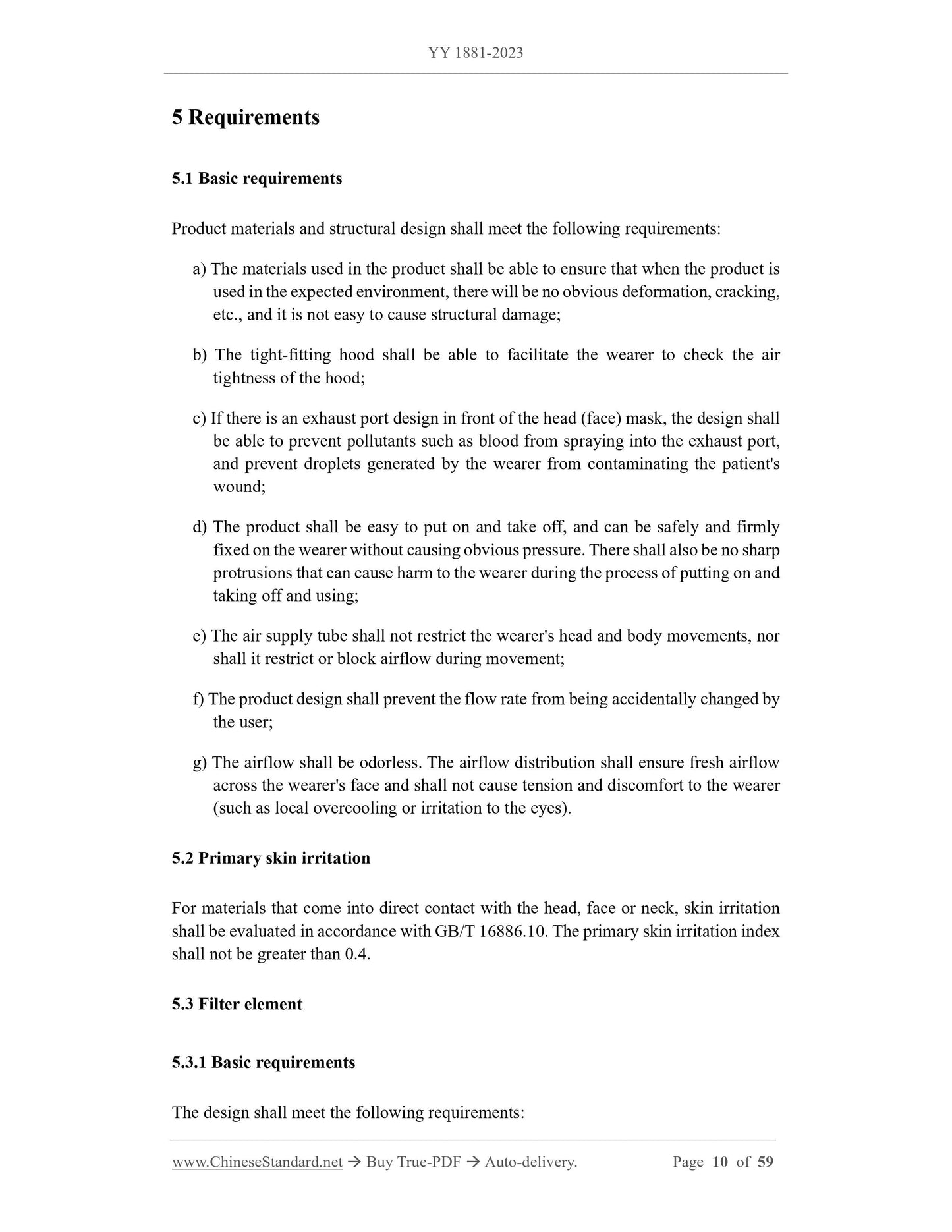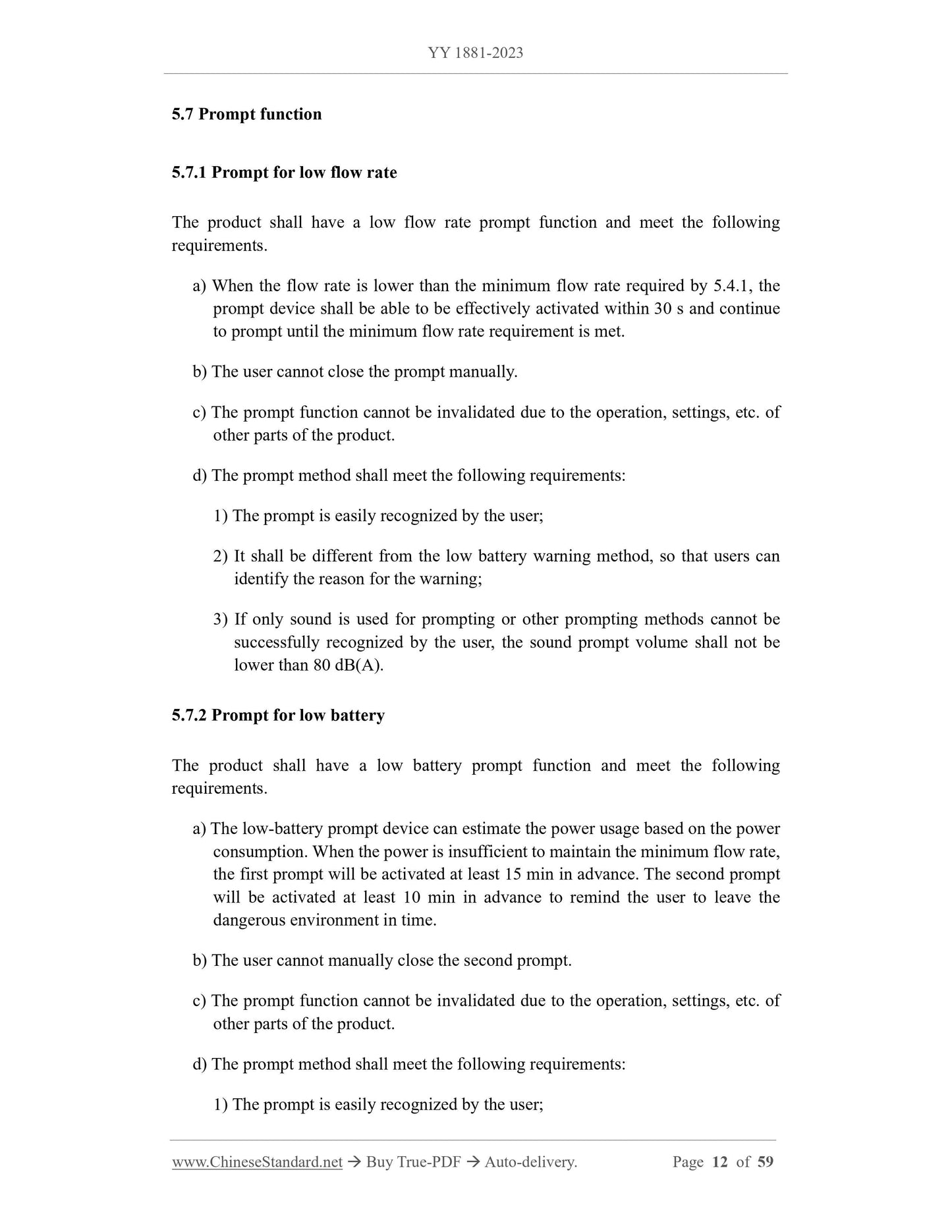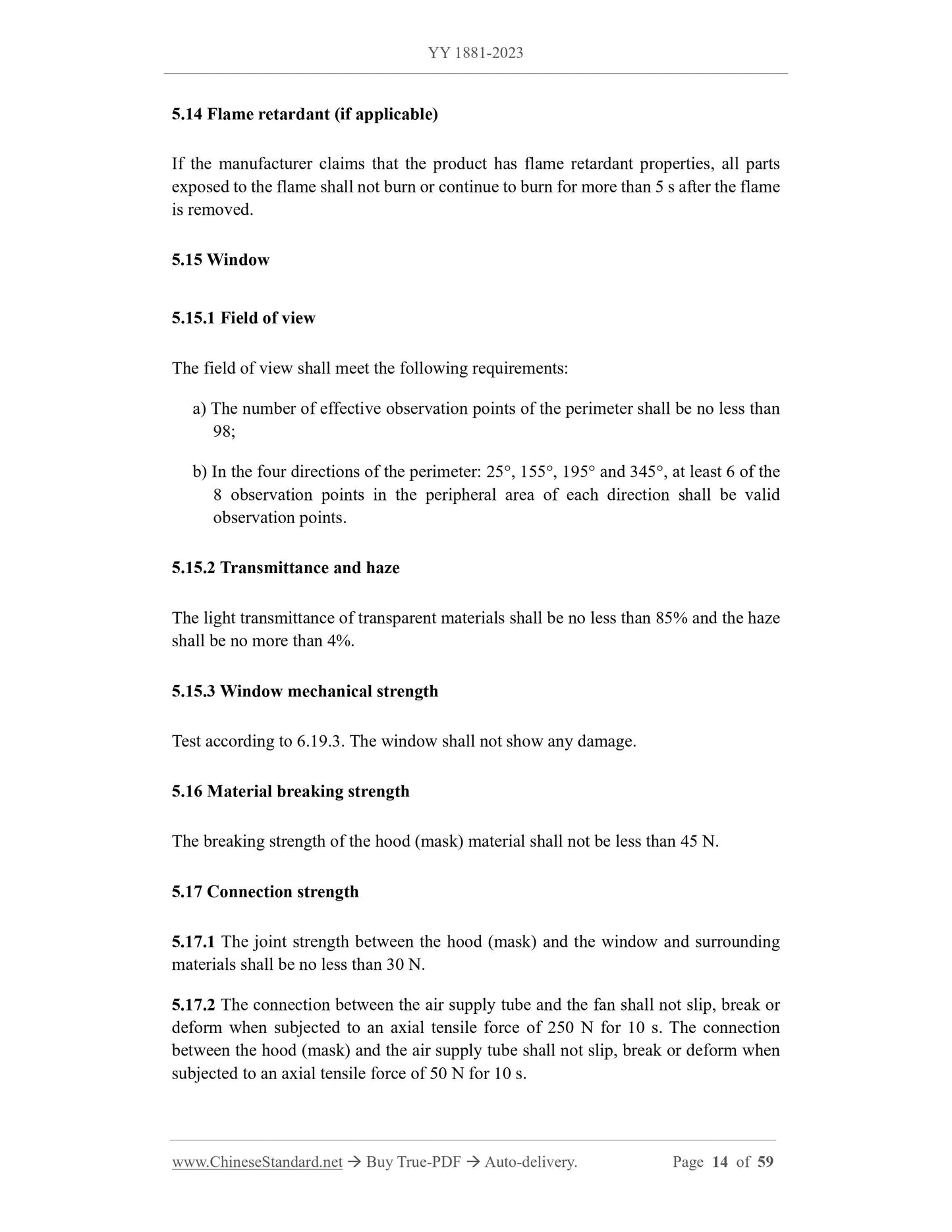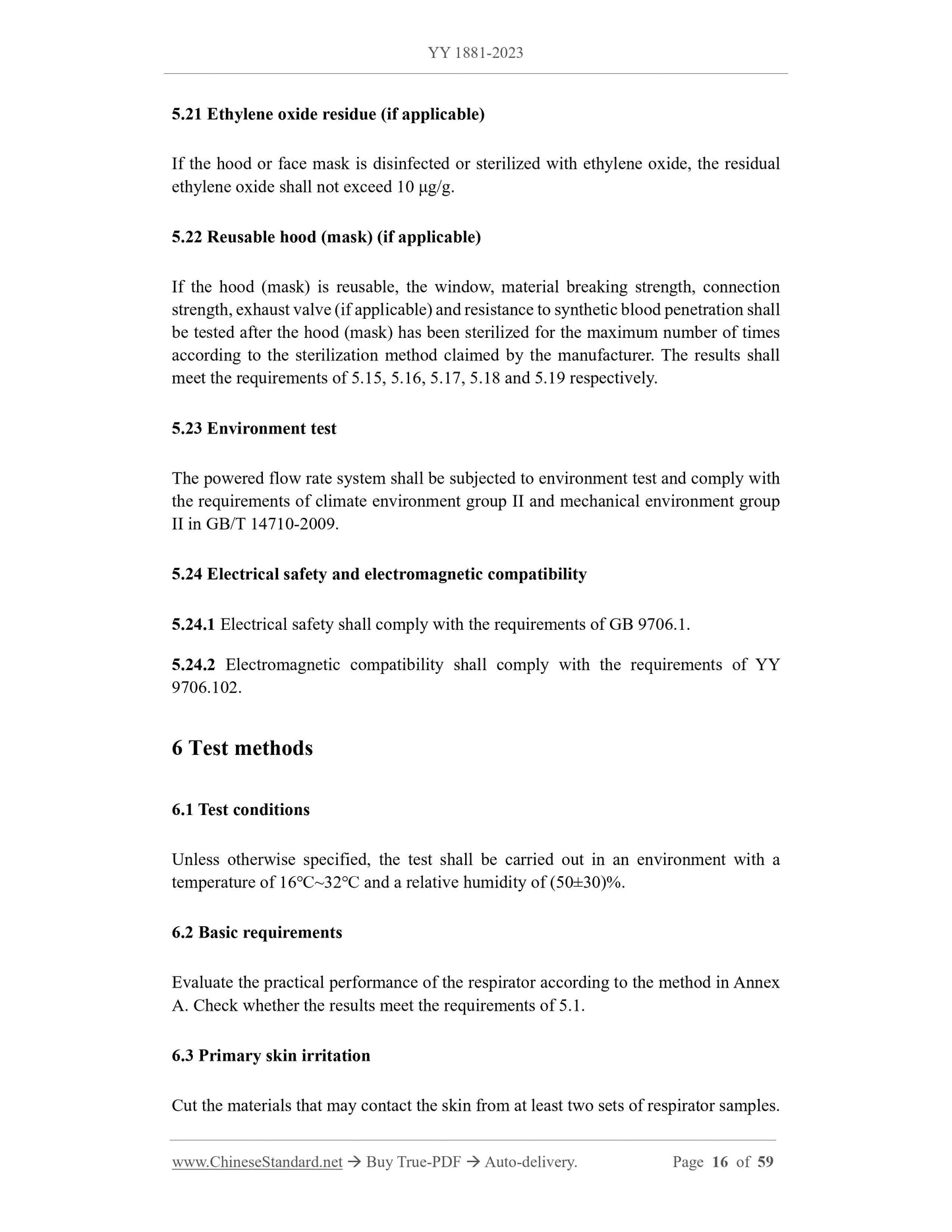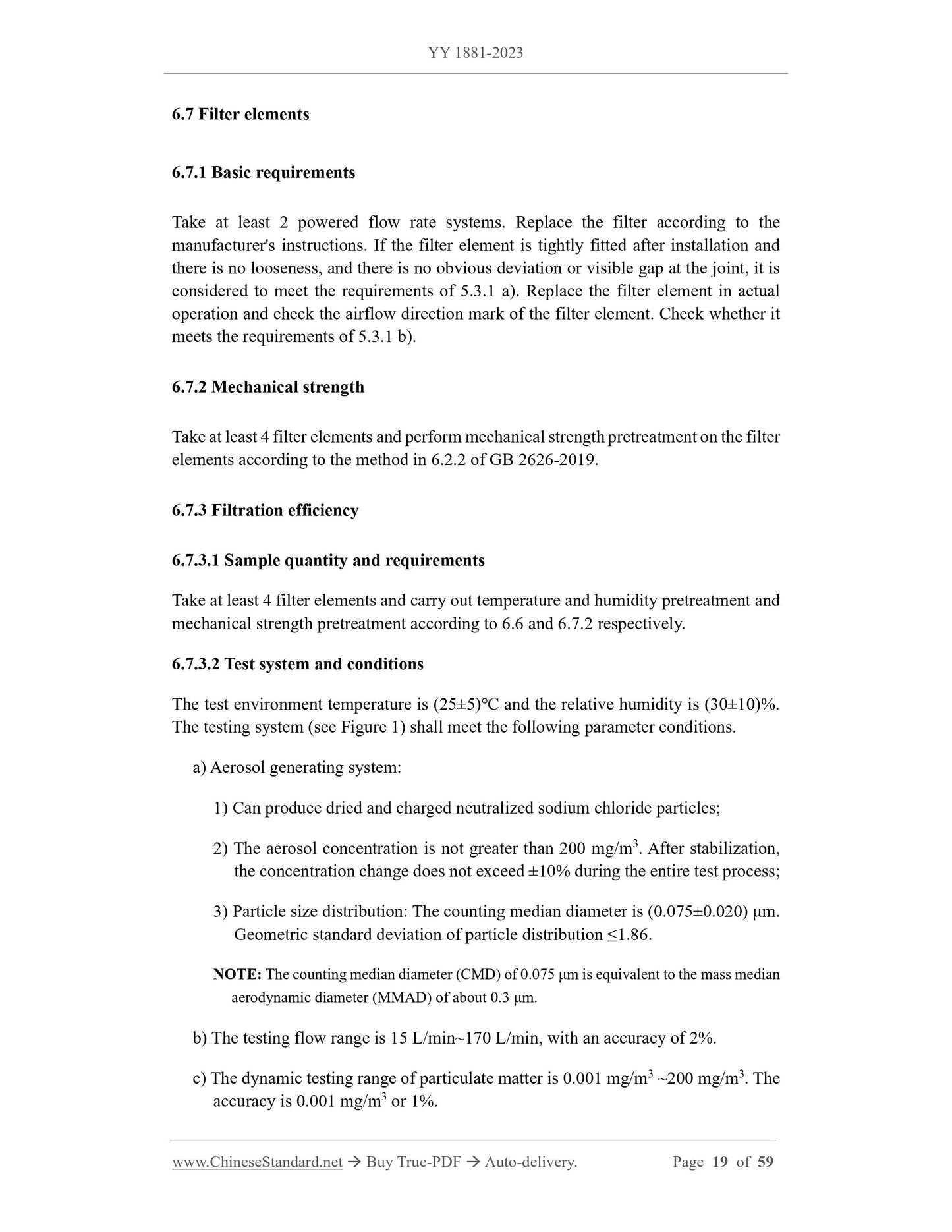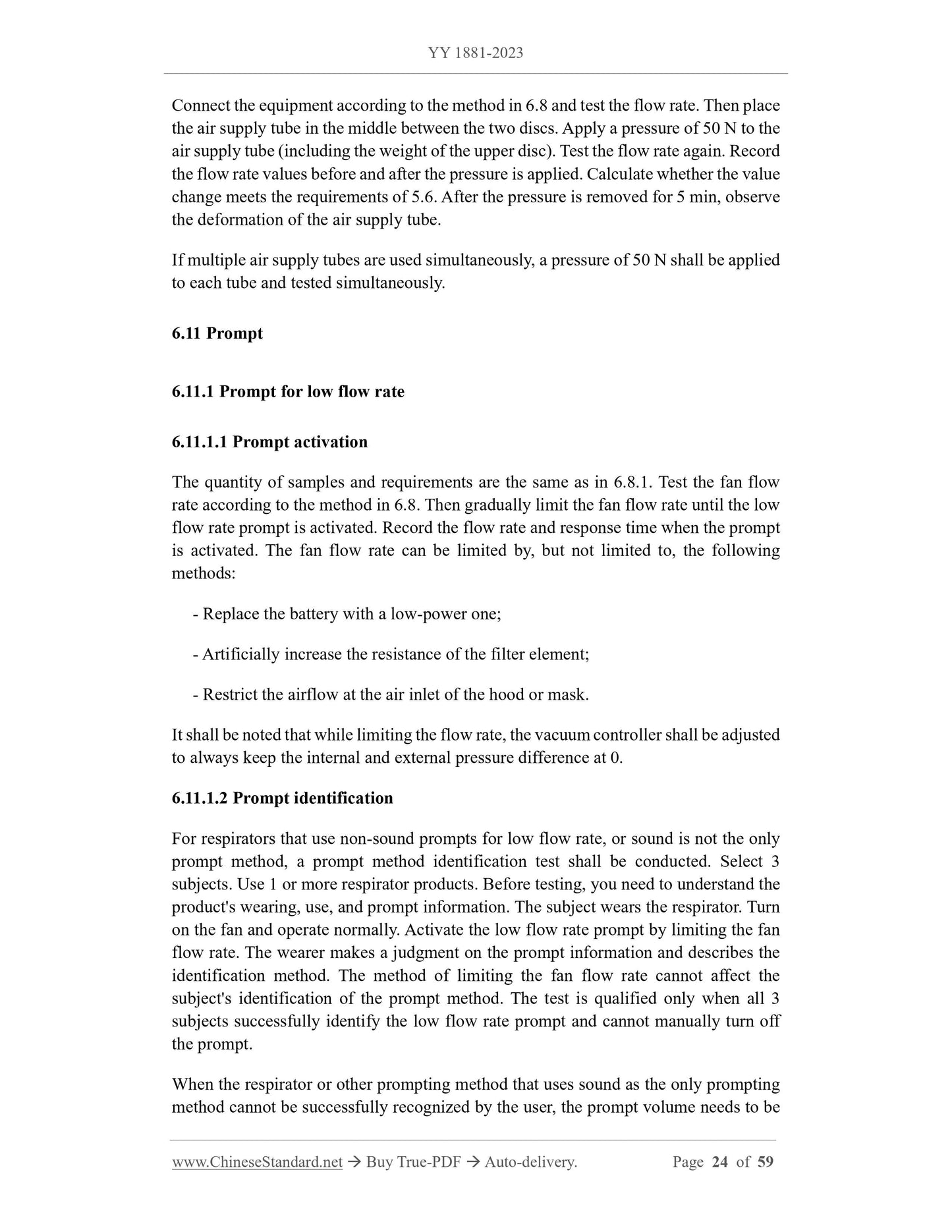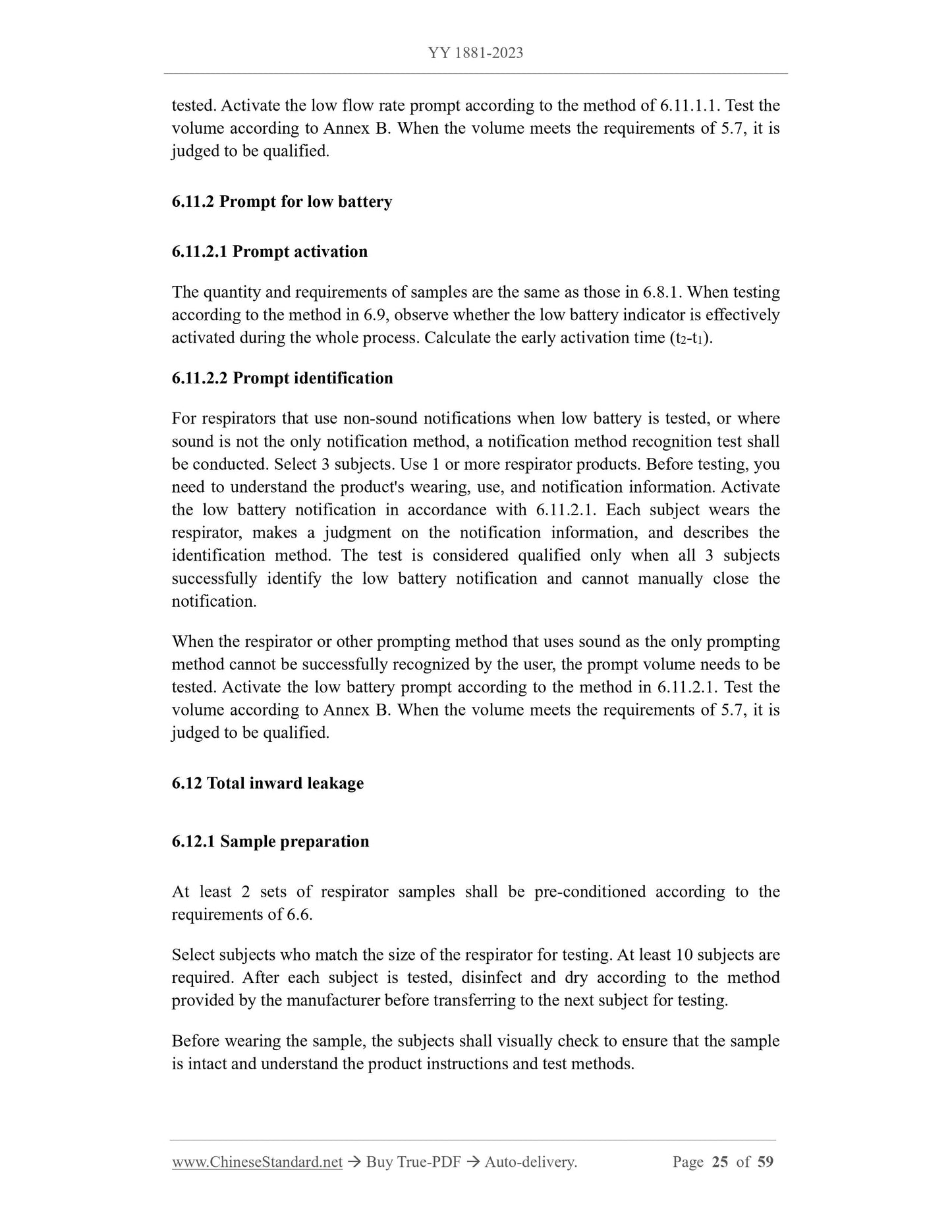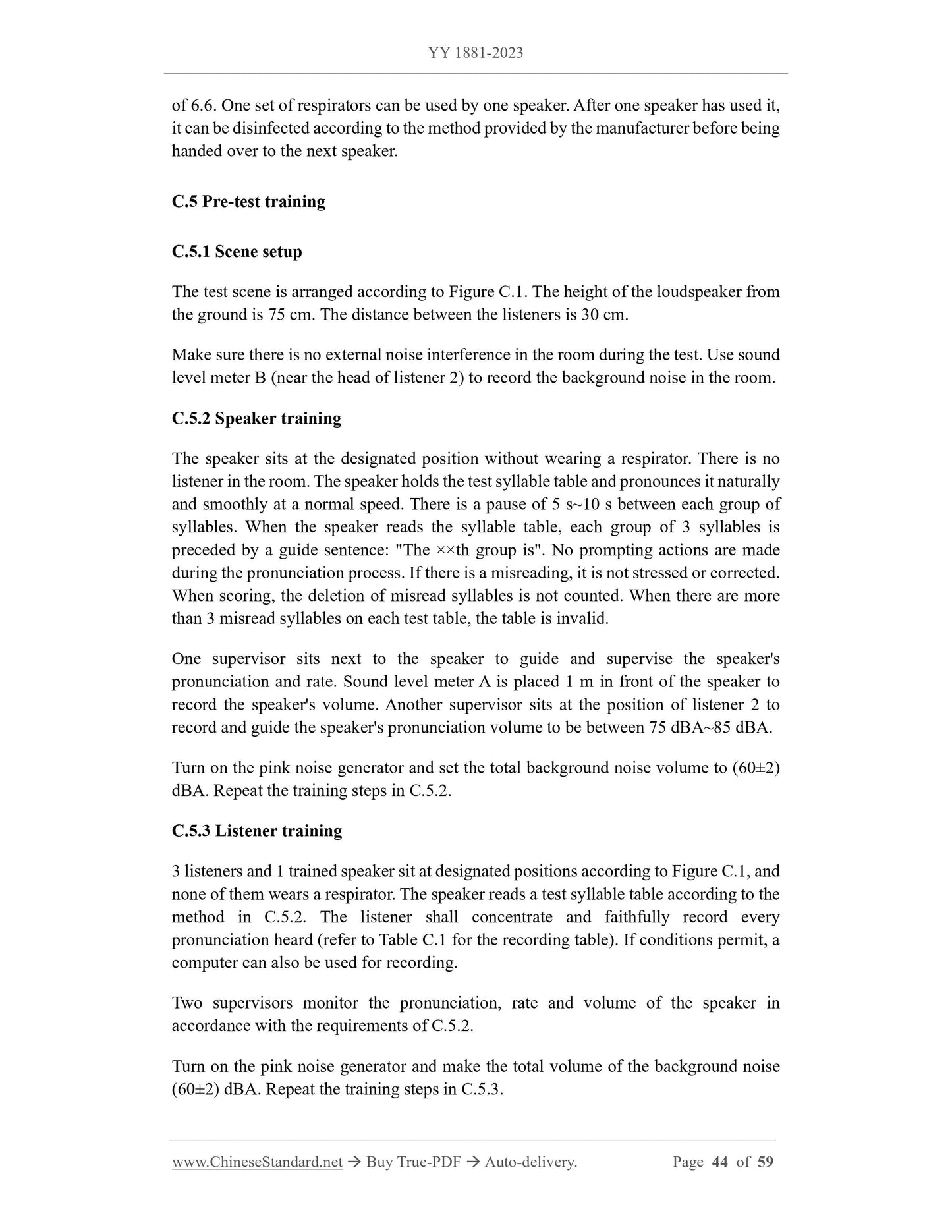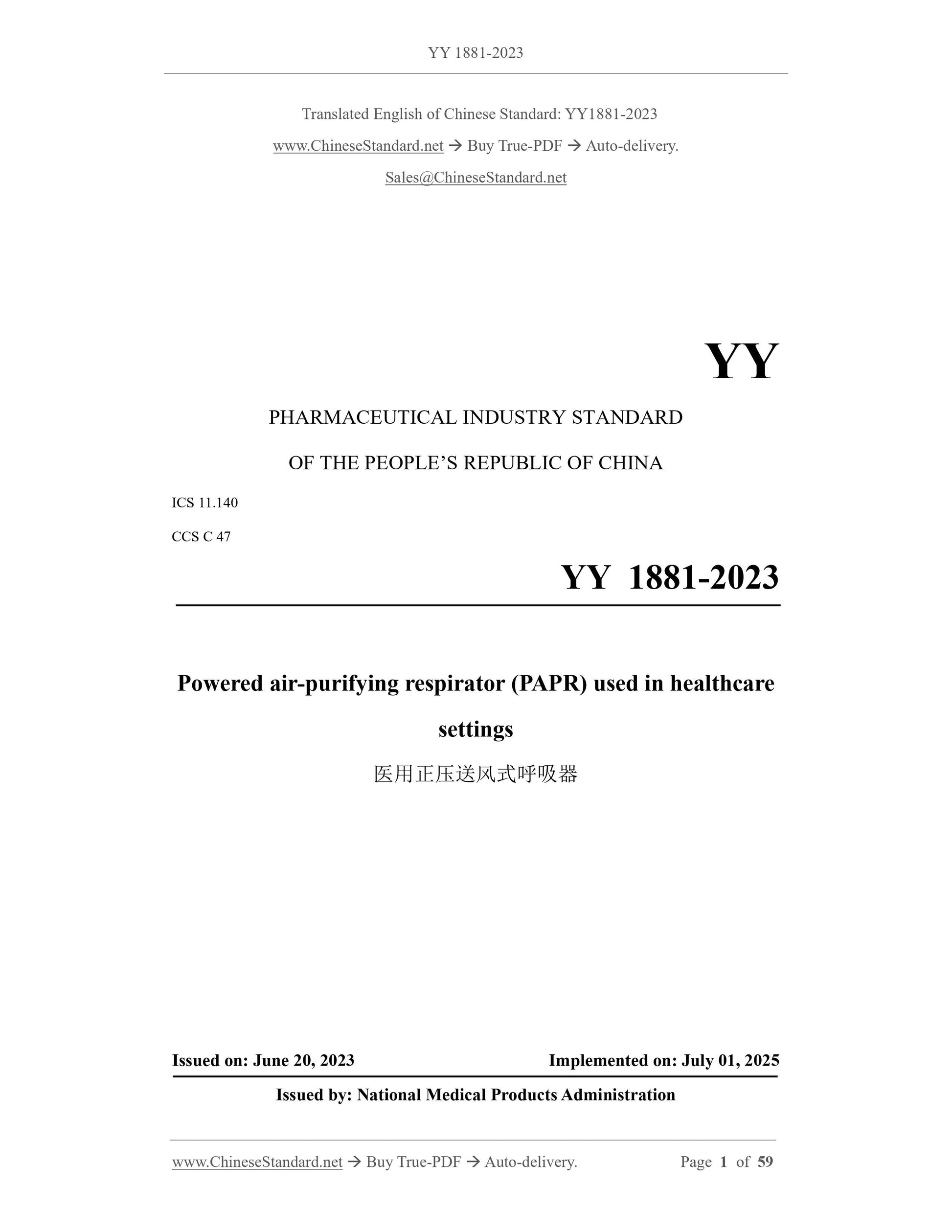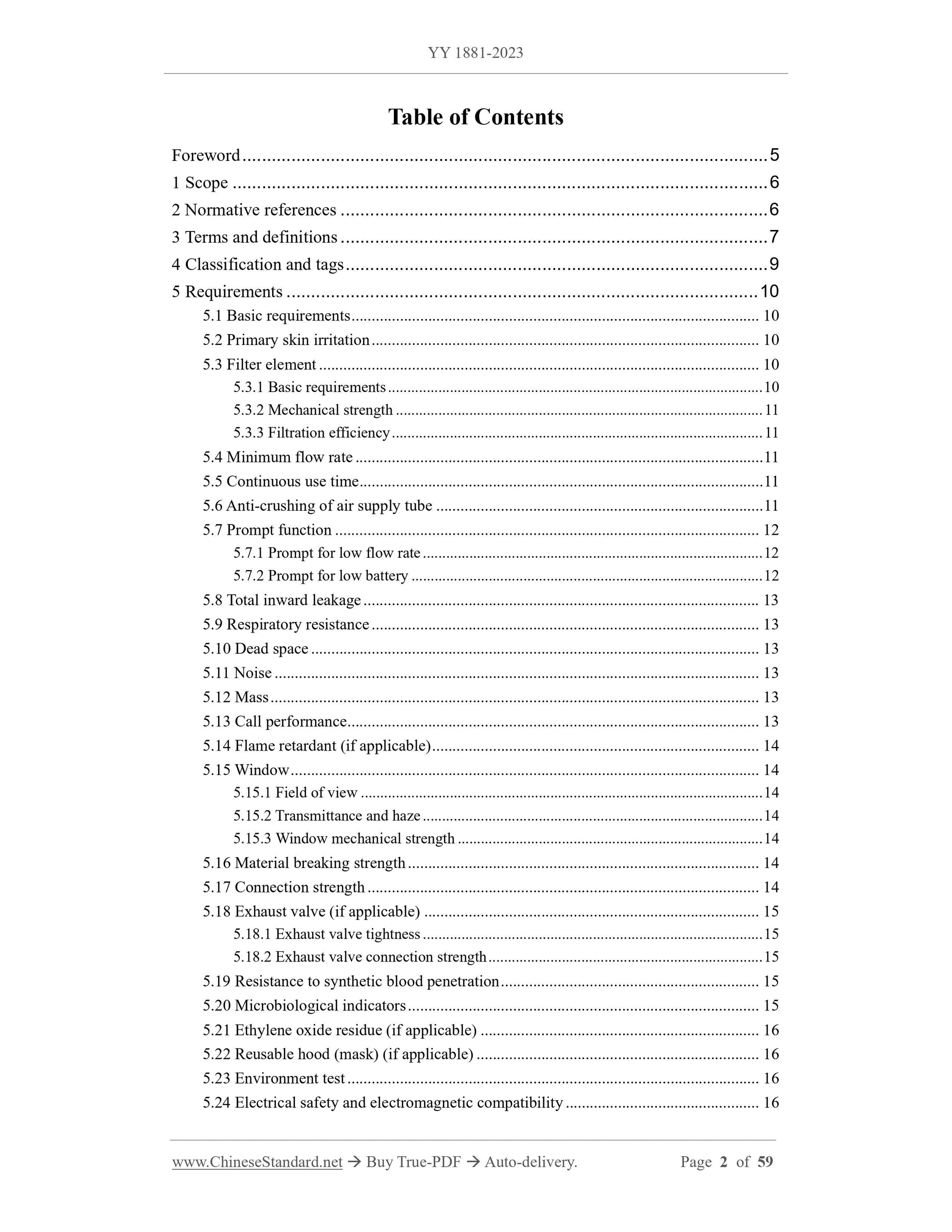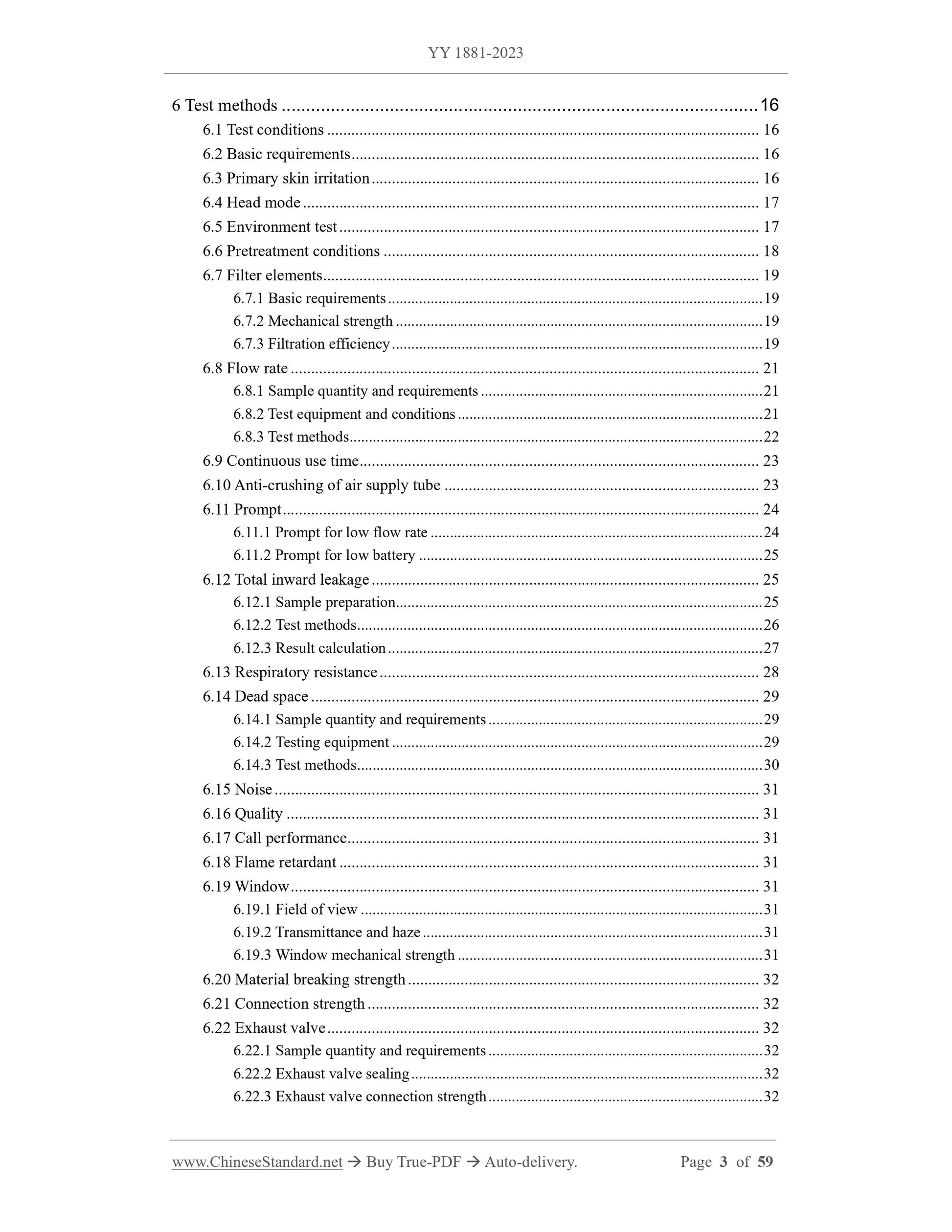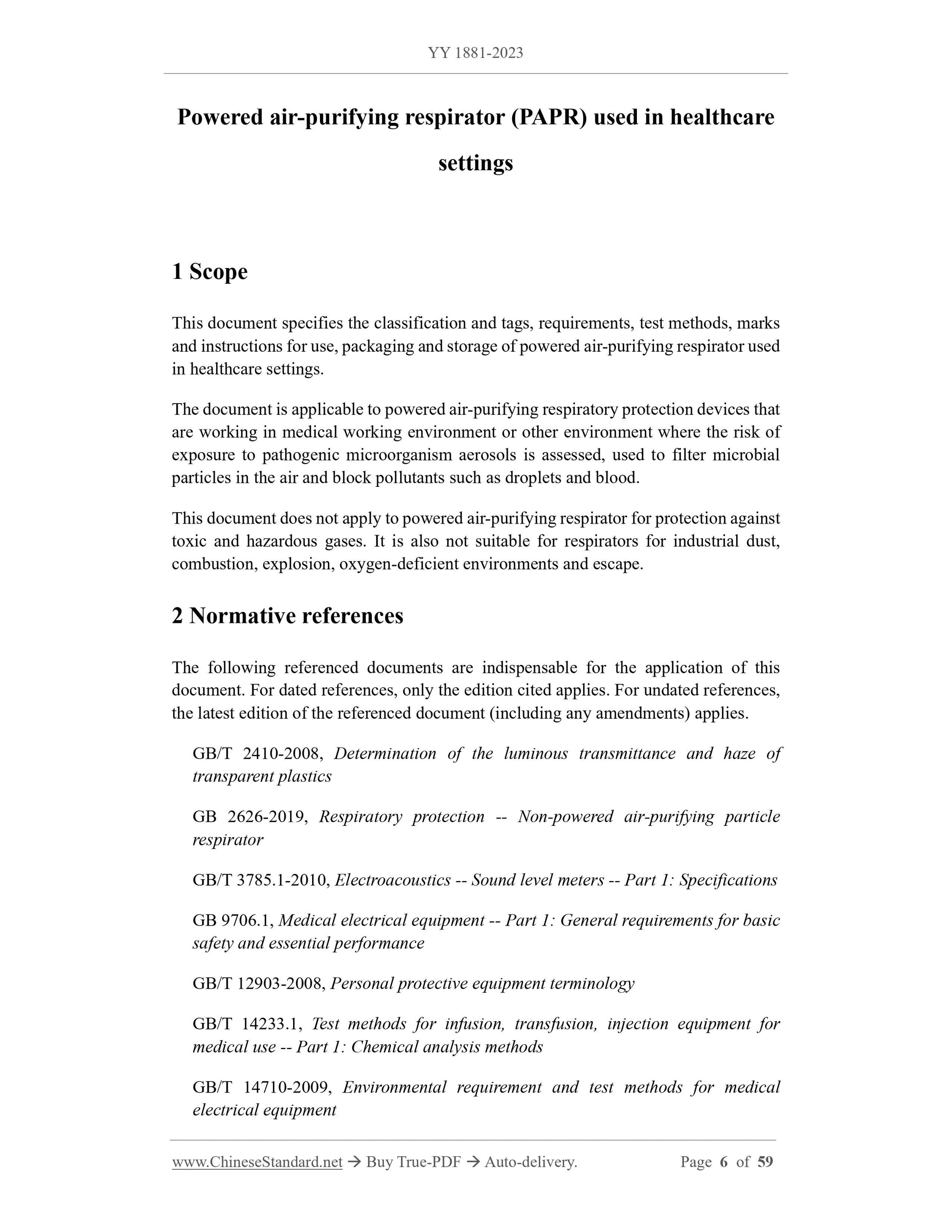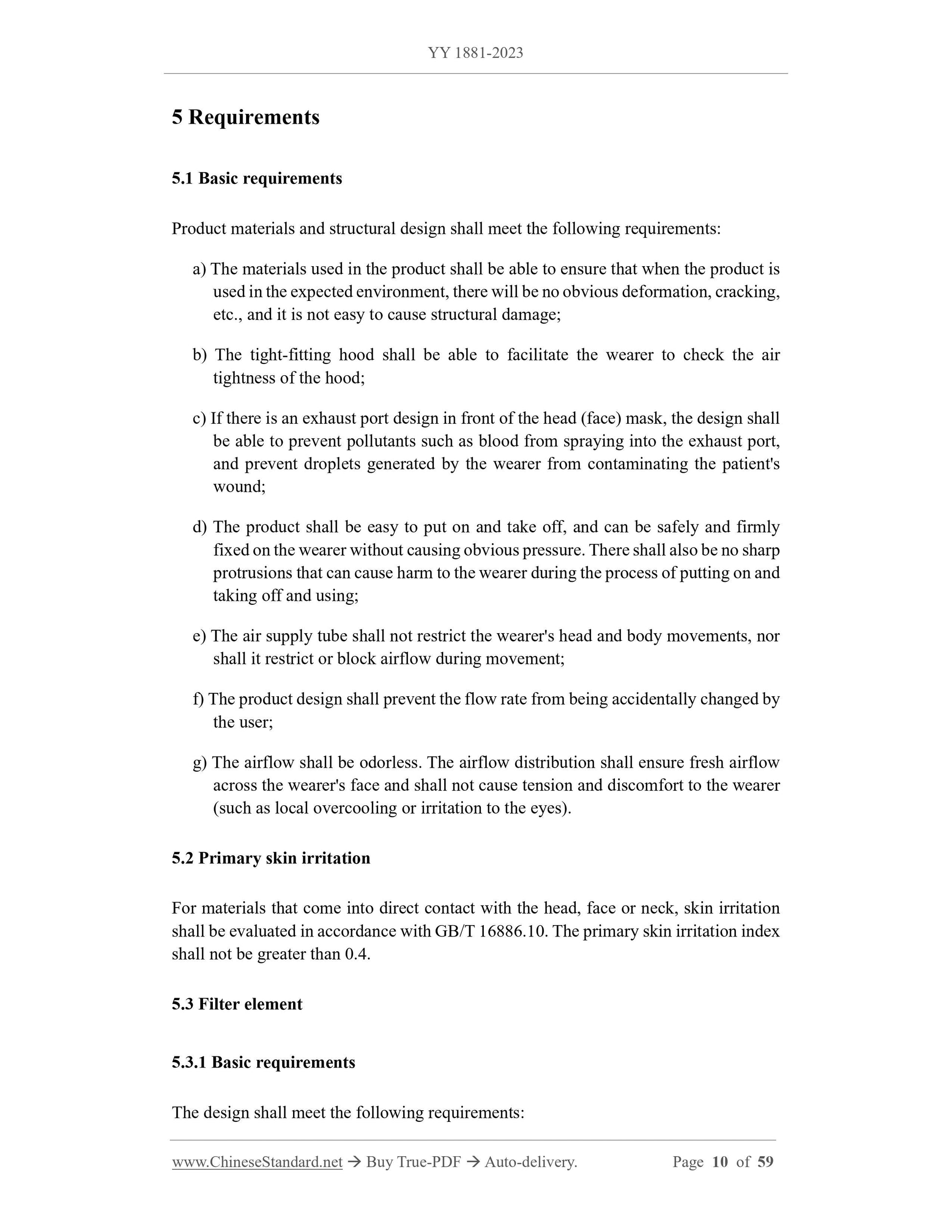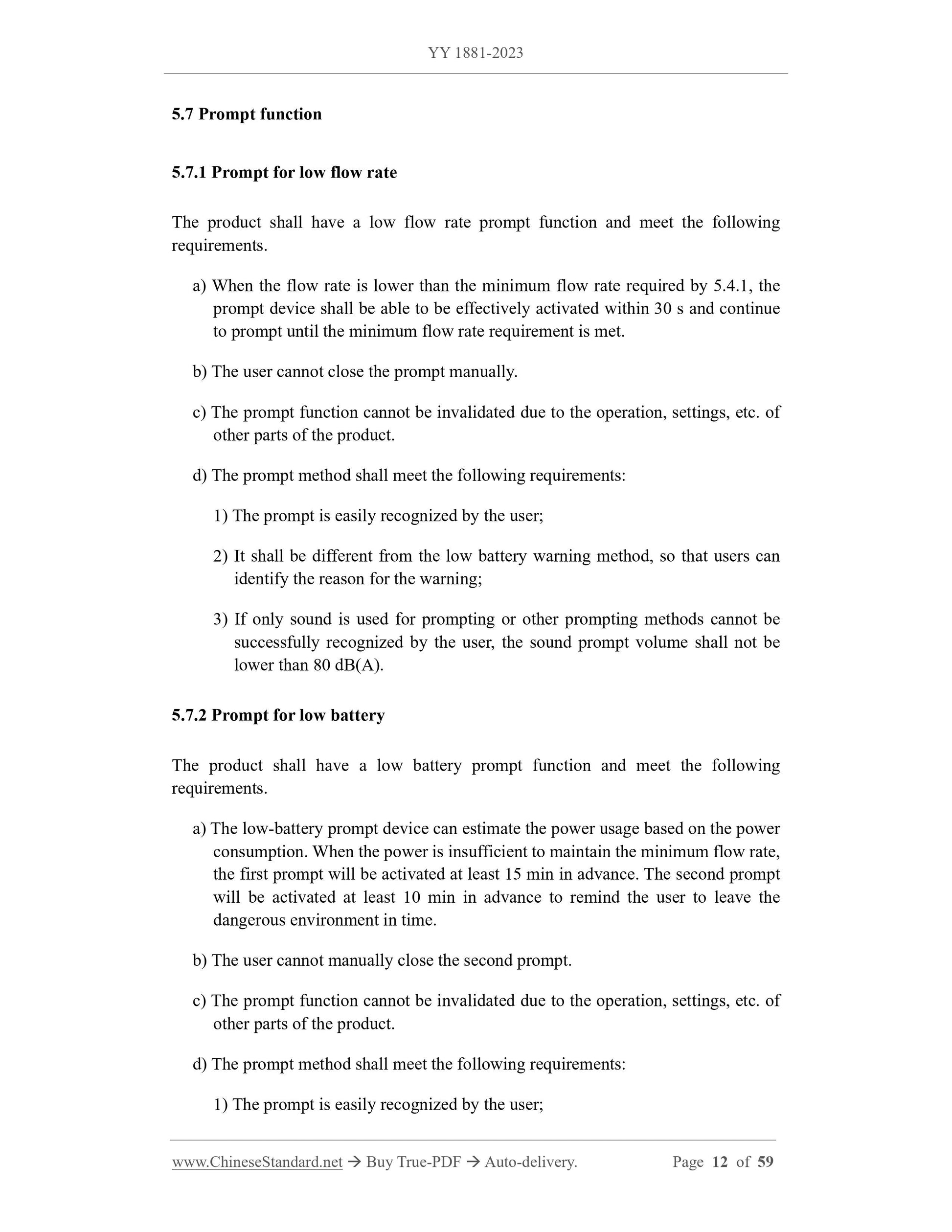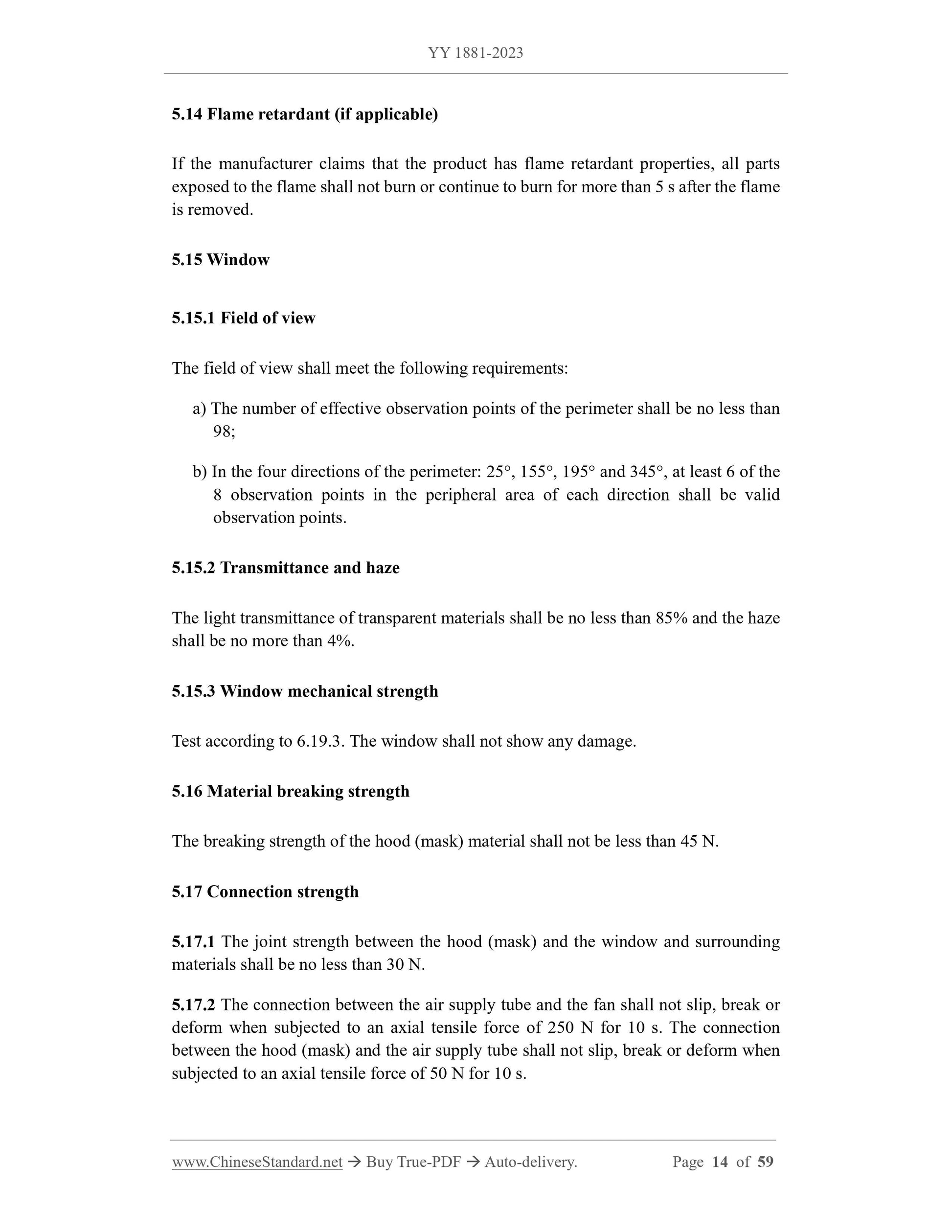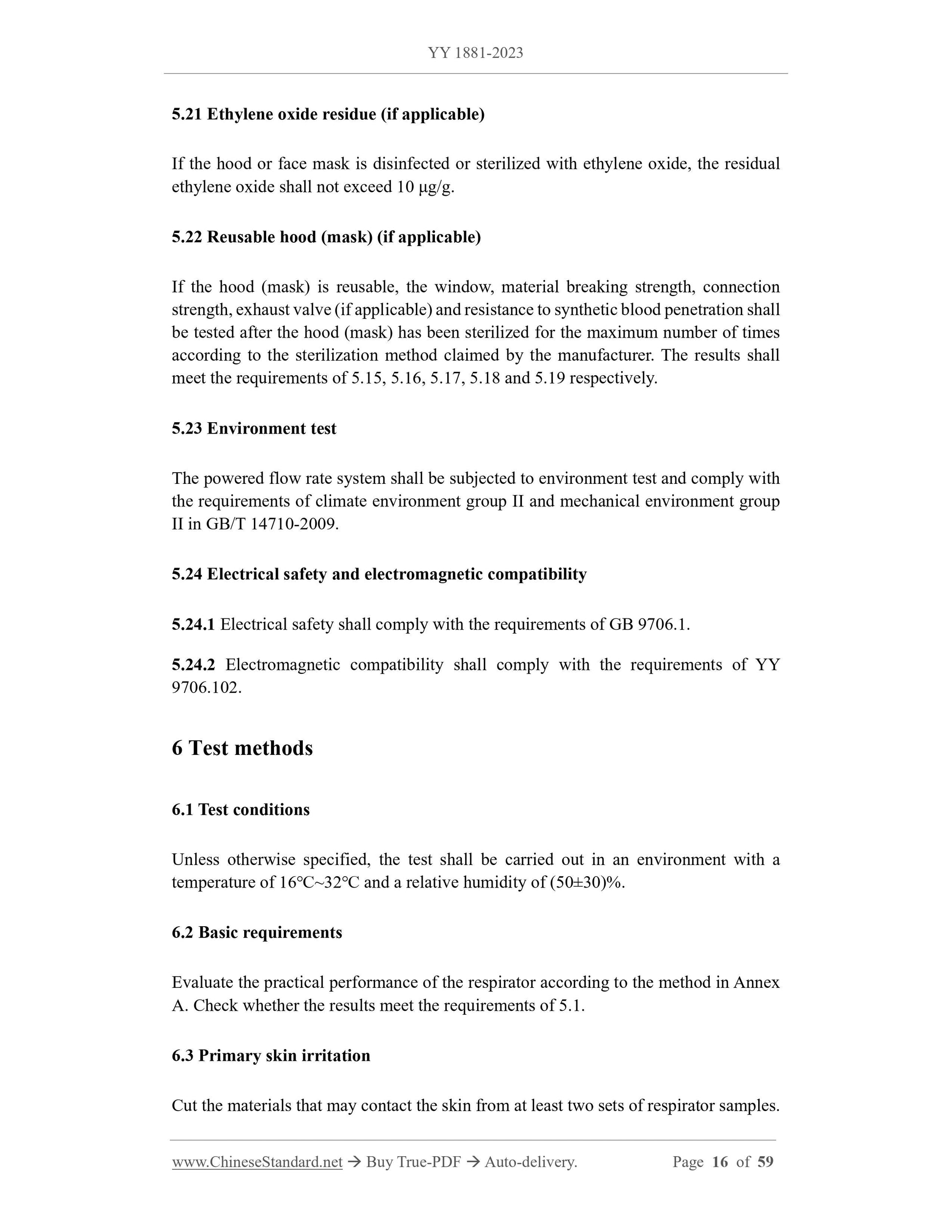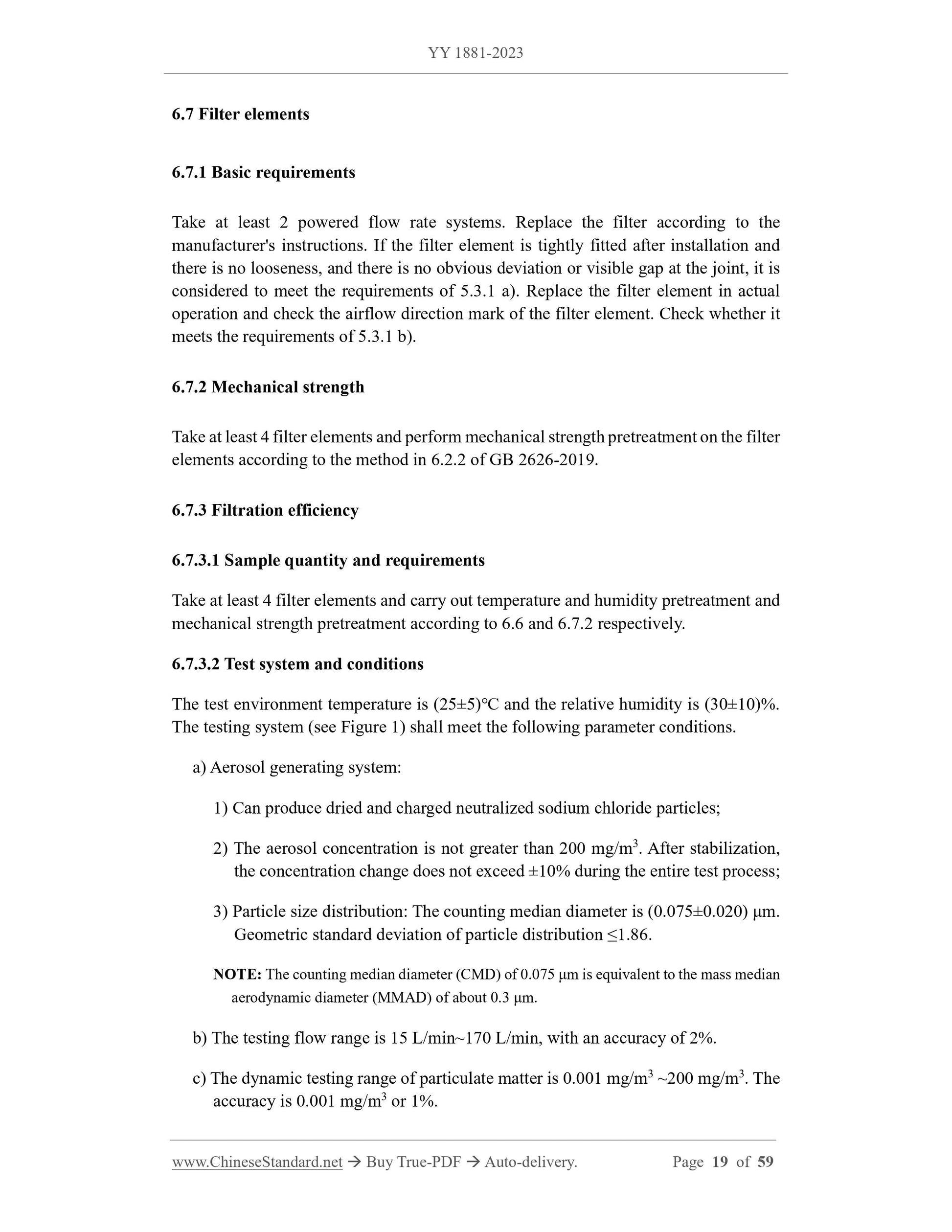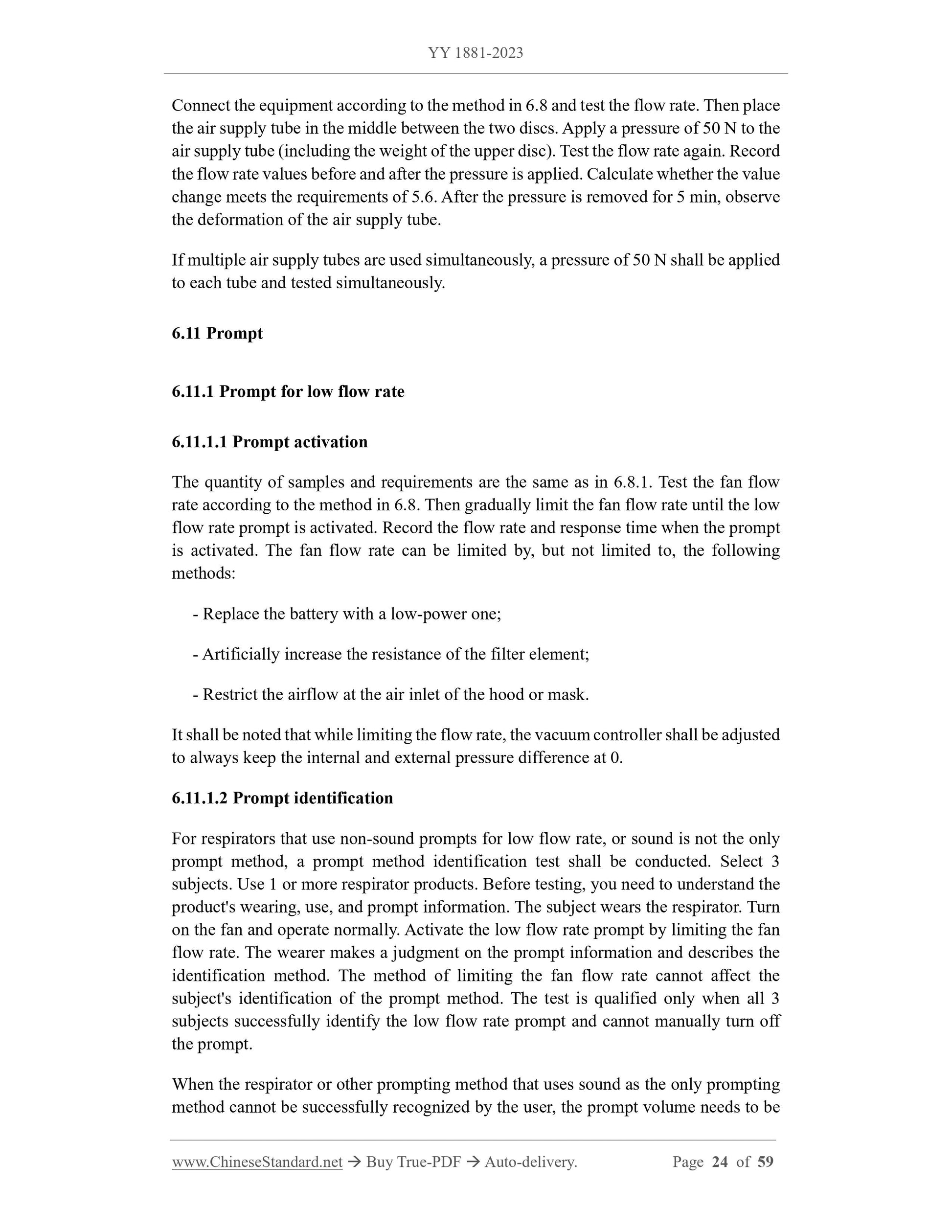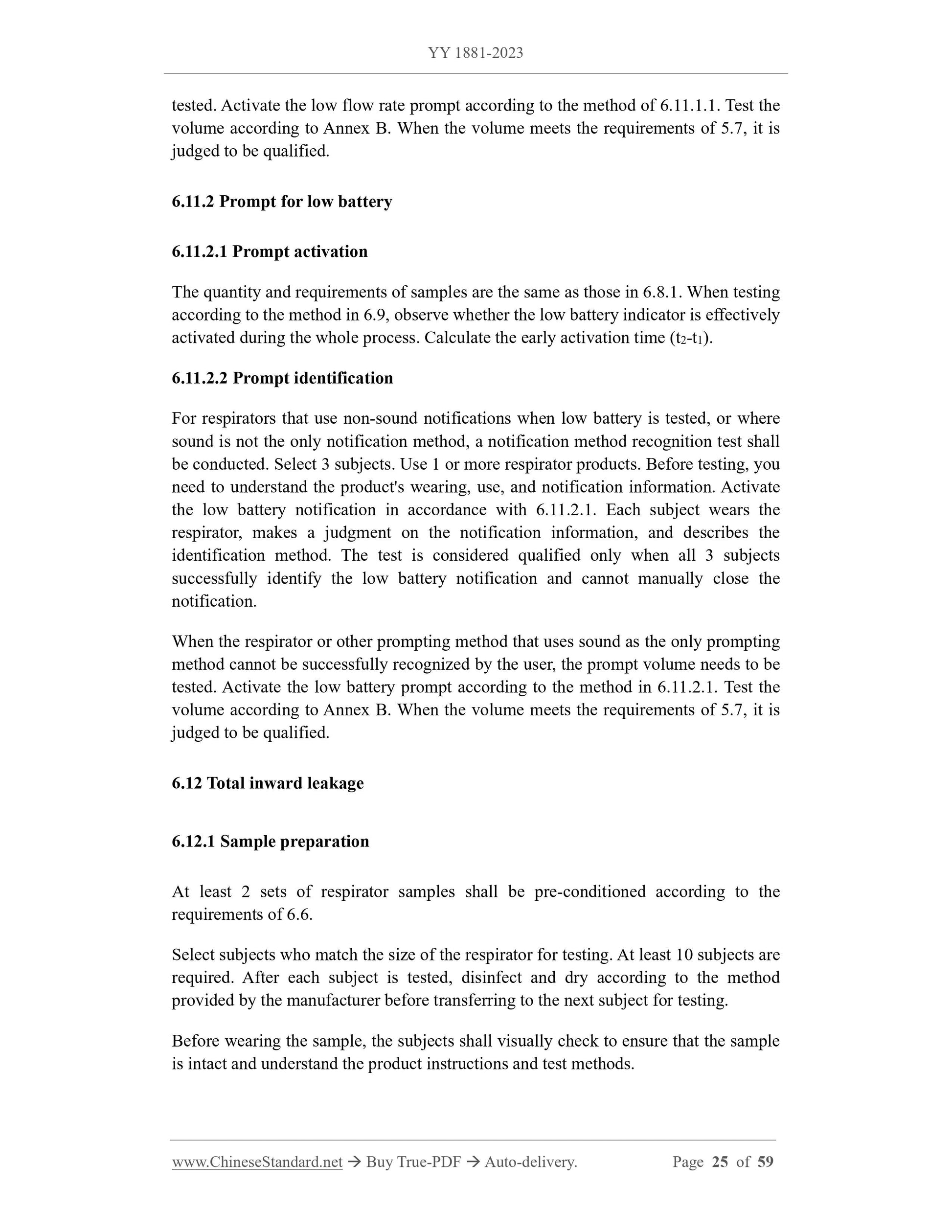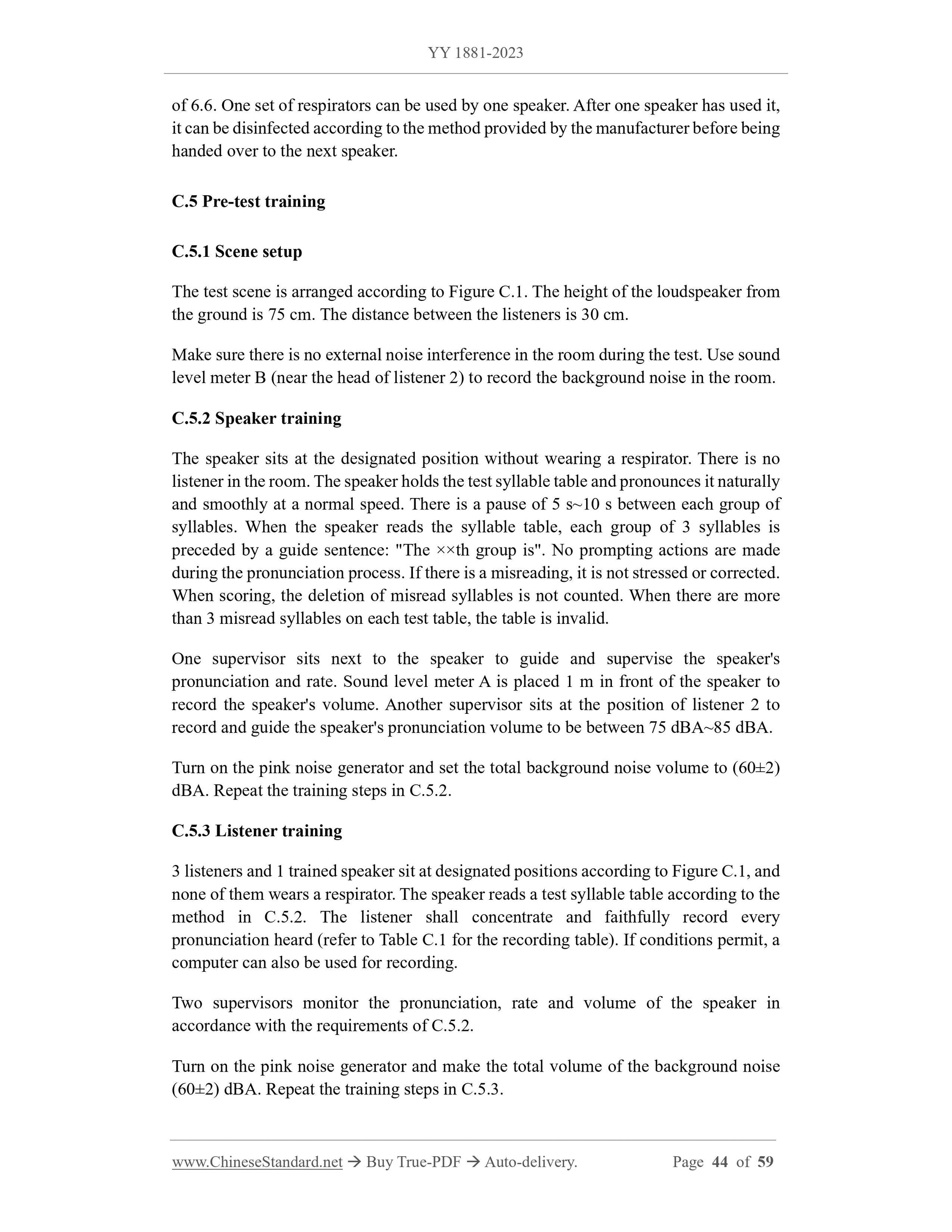1
/
su
12
PayPal, credit cards. Download editable-PDF and invoice in 1 second!
YY 1881-2023 English PDF (YY1881-2023)
YY 1881-2023 English PDF (YY1881-2023)
Prezzo di listino
$860.00 USD
Prezzo di listino
Prezzo scontato
$860.00 USD
Prezzo unitario
/
per
Spese di spedizione calcolate al check-out.
Impossibile caricare la disponibilità di ritiro
Delivery: 3 seconds. Download true-PDF + Invoice.
Get QUOTATION in 1-minute: Click YY 1881-2023
Historical versions: YY 1881-2023
Preview True-PDF (Reload/Scroll if blank)
YY 1881-2023: Powered air-purifying respirator (PAPR) used in healthcare settings
YY 1881-2023
YY
PHARMACEUTICAL INDUSTRY STANDARD
OF THE PEOPLE’S REPUBLIC OF CHINA
ICS 11.140
CCS C 47
Powered air-purifying respirator (PAPR) used in healthcare
settings
ISSUED ON: JUNE 20, 2023
IMPLEMENTED ON: JULY 01, 2025
Issued by: National Medical Products Administration
Table of Contents
Foreword ... 5
1 Scope ... 6
2 Normative references ... 6
3 Terms and definitions ... 7
4 Classification and tags ... 9
5 Requirements ... 10
5.1 Basic requirements ... 10
5.2 Primary skin irritation ... 10
5.3 Filter element ... 10
5.3.1 Basic requirements ... 10
5.3.2 Mechanical strength ... 11
5.3.3 Filtration efficiency ... 11
5.4 Minimum flow rate ... 11
5.5 Continuous use time ... 11
5.6 Anti-crushing of air supply tube ... 11
5.7 Prompt function ... 12
5.7.1 Prompt for low flow rate ... 12
5.7.2 Prompt for low battery ... 12
5.8 Total inward leakage ... 13
5.9 Respiratory resistance ... 13
5.10 Dead space ... 13
5.11 Noise ... 13
5.12 Mass ... 13
5.13 Call performance ... 13
5.14 Flame retardant (if applicable) ... 14
5.15 Window ... 14
5.15.1 Field of view ... 14
5.15.2 Transmittance and haze ... 14
5.15.3 Window mechanical strength ... 14
5.16 Material breaking strength ... 14
5.17 Connection strength ... 14
5.18 Exhaust valve (if applicable) ... 15
5.18.1 Exhaust valve tightness ... 15
5.18.2 Exhaust valve connection strength ... 15
5.19 Resistance to synthetic blood penetration ... 15
5.20 Microbiological indicators ... 15
5.21 Ethylene oxide residue (if applicable) ... 16
5.22 Reusable hood (mask) (if applicable) ... 16
5.23 Environment test ... 16
5.24 Electrical safety and electromagnetic compatibility ... 16
6 Test methods ... 16
6.1 Test conditions ... 16
6.2 Basic requirements ... 16
6.3 Primary skin irritation ... 16
6.4 Head mode ... 17
6.5 Environment test ... 17
6.6 Pretreatment conditions ... 18
6.7 Filter elements ... 19
6.7.1 Basic requirements ... 19
6.7.2 Mechanical strength ... 19
6.7.3 Filtration efficiency ... 19
6.8 Flow rate ... 21
6.8.1 Sample quantity and requirements ... 21
6.8.2 Test equipment and conditions ... 21
6.8.3 Test methods ... 22
6.9 Continuous use time ... 23
6.10 Anti-crushing of air supply tube ... 23
6.11 Prompt ... 24
6.11.1 Prompt for low flow rate ... 24
6.11.2 Prompt for low battery ... 25
6.12 Total inward leakage ... 25
6.12.1 Sample preparation ... 25
6.12.2 Test methods ... 26
6.12.3 Result calculation ... 27
6.13 Respiratory resistance ... 28
6.14 Dead space ... 29
6.14.1 Sample quantity and requirements ... 29
6.14.2 Testing equipment ... 29
6.14.3 Test methods ... 30
6.15 Noise ... 31
6.16 Quality ... 31
6.17 Call performance ... 31
6.18 Flame retardant ... 31
6.19 Window ... 31
6.19.1 Field of view ... 31
6.19.2 Transmittance and haze ... 31
6.19.3 Window mechanical strength ... 31
6.20 Material breaking strength ... 32
6.21 Connection strength ... 32
6.22 Exhaust valve ... 32
6.22.1 Sample quantity and requirements ... 32
6.22.2 Exhaust valve sealing ... 32
6.22.3 Exhaust valve connection strength ... 32
Powered air-purifying respirator (PAPR) used in healthcare
settings
1 Scope
This document specifies the classification and tags, requirements, test methods, marks
and instructions for use, packaging and storage of powered air-purifying respirator used
in healthcare settings.
The document is applicable to powered air-purifying respiratory protection devices that
are working in medical working environment or other environment where the risk of
exposure to pathogenic microorganism aerosols is assessed, used to filter microbial
particles in the air and block pollutants such as droplets and blood.
This document does not apply to powered air-purifying respirator for protection against
toxic and hazardous gases. It is also not suitable for respirators for industrial dust,
combustion, explosion, oxygen-deficient environments and escape.
2 Normative references
The following referenced documents are indispensable for the application of this
document. For dated references, only the edition cited applies. For undated references,
the latest edition of the referenced document (including any amendments) applies.
GB/T 2410-2008, Determination of the luminous transmittance and haze of
transparent plastics
GB 2626-2019, Respiratory protection -- Non-powered air-purifying particle
respirator
GB/T 3785.1-2010, Electroacoustics -- Sound level meters -- Part 1: Specifications
GB 9706.1, Medical electrical equipment -- Part 1: General requirements for basic
safety and essential performance
GB/T 12903-2008, Personal protective equipment terminology
GB/T 14233.1, Test methods for infusion, transfusion, injection equipment for
medical use -- Part 1: Chemical analysis methods
GB/T 14710-2009, Environmental requirement and test methods for medical
electrical equipment
5 Requirements
5.1 Basic requirements
Product materials and structural design shall meet the following requirements:
a) The materials used in the product shall be able to ensure that when the product is
used in the expected environment, there will be no obvious deformation, cracking,
etc., and it is not easy to cause structural damage;
b) The tight-fitting hood shall be able to facilitate the wearer to check the air
tightness of the hood;
c) If there is an exhaust port design in front of the head (face) mask, the design shall
be able to prevent pollutants such as blood from spraying into the exhaust port,
and prevent droplets generated by the wearer from contaminating the patient's
wound;
d) The product shall be easy to put on and take off, and can be safely and firmly
fixed on the wearer without causing obvious pressure. There shall also be no sharp
protrusions that can cause harm to the wearer during the process of putting on and
taking off and using;
e) The air supply tube shall not restrict the wearer's head and body movements, nor
shall it restrict or block airflow during movement;
f) The product design shall prevent the flow rate from being accidentally changed by
the user;
g) The airflow shall be odorless. The airflow distribution shall ensure fresh airflow
across the wearer's face and shall not cause tension and discomfort to the wearer
(such as local overcooling or irritation to the eyes).
5.2 Primary skin irritation
For materials that come into direct contact with the head, face or neck, skin irritation
shall be evaluated in accordance with GB/T 16886.10. The primary skin irritation index
shall not be greater than 0.4.
5.3 Filter element
5.3.1 Basic requirements
The design shall meet the following requirements:
5.7 Prompt function
5.7.1 Prompt for low flow rate
The product shall have a low flow rate prompt function and meet the following
requirements.
a) When the flow rate is lower than the minimum flow rate required by 5.4.1, the
prompt device shall be able to be effectively activated within 30 s and continue
to prompt until the minimum flow rate requirement is met.
b) The user cannot close the prompt manually.
c) The prompt function cannot be invalidated due to the operation, settings, etc. of
other parts of the product.
d) The prompt method shall meet the following requirements:
1) The prompt is easily recognized by the user;
2) It s...
Get QUOTATION in 1-minute: Click YY 1881-2023
Historical versions: YY 1881-2023
Preview True-PDF (Reload/Scroll if blank)
YY 1881-2023: Powered air-purifying respirator (PAPR) used in healthcare settings
YY 1881-2023
YY
PHARMACEUTICAL INDUSTRY STANDARD
OF THE PEOPLE’S REPUBLIC OF CHINA
ICS 11.140
CCS C 47
Powered air-purifying respirator (PAPR) used in healthcare
settings
ISSUED ON: JUNE 20, 2023
IMPLEMENTED ON: JULY 01, 2025
Issued by: National Medical Products Administration
Table of Contents
Foreword ... 5
1 Scope ... 6
2 Normative references ... 6
3 Terms and definitions ... 7
4 Classification and tags ... 9
5 Requirements ... 10
5.1 Basic requirements ... 10
5.2 Primary skin irritation ... 10
5.3 Filter element ... 10
5.3.1 Basic requirements ... 10
5.3.2 Mechanical strength ... 11
5.3.3 Filtration efficiency ... 11
5.4 Minimum flow rate ... 11
5.5 Continuous use time ... 11
5.6 Anti-crushing of air supply tube ... 11
5.7 Prompt function ... 12
5.7.1 Prompt for low flow rate ... 12
5.7.2 Prompt for low battery ... 12
5.8 Total inward leakage ... 13
5.9 Respiratory resistance ... 13
5.10 Dead space ... 13
5.11 Noise ... 13
5.12 Mass ... 13
5.13 Call performance ... 13
5.14 Flame retardant (if applicable) ... 14
5.15 Window ... 14
5.15.1 Field of view ... 14
5.15.2 Transmittance and haze ... 14
5.15.3 Window mechanical strength ... 14
5.16 Material breaking strength ... 14
5.17 Connection strength ... 14
5.18 Exhaust valve (if applicable) ... 15
5.18.1 Exhaust valve tightness ... 15
5.18.2 Exhaust valve connection strength ... 15
5.19 Resistance to synthetic blood penetration ... 15
5.20 Microbiological indicators ... 15
5.21 Ethylene oxide residue (if applicable) ... 16
5.22 Reusable hood (mask) (if applicable) ... 16
5.23 Environment test ... 16
5.24 Electrical safety and electromagnetic compatibility ... 16
6 Test methods ... 16
6.1 Test conditions ... 16
6.2 Basic requirements ... 16
6.3 Primary skin irritation ... 16
6.4 Head mode ... 17
6.5 Environment test ... 17
6.6 Pretreatment conditions ... 18
6.7 Filter elements ... 19
6.7.1 Basic requirements ... 19
6.7.2 Mechanical strength ... 19
6.7.3 Filtration efficiency ... 19
6.8 Flow rate ... 21
6.8.1 Sample quantity and requirements ... 21
6.8.2 Test equipment and conditions ... 21
6.8.3 Test methods ... 22
6.9 Continuous use time ... 23
6.10 Anti-crushing of air supply tube ... 23
6.11 Prompt ... 24
6.11.1 Prompt for low flow rate ... 24
6.11.2 Prompt for low battery ... 25
6.12 Total inward leakage ... 25
6.12.1 Sample preparation ... 25
6.12.2 Test methods ... 26
6.12.3 Result calculation ... 27
6.13 Respiratory resistance ... 28
6.14 Dead space ... 29
6.14.1 Sample quantity and requirements ... 29
6.14.2 Testing equipment ... 29
6.14.3 Test methods ... 30
6.15 Noise ... 31
6.16 Quality ... 31
6.17 Call performance ... 31
6.18 Flame retardant ... 31
6.19 Window ... 31
6.19.1 Field of view ... 31
6.19.2 Transmittance and haze ... 31
6.19.3 Window mechanical strength ... 31
6.20 Material breaking strength ... 32
6.21 Connection strength ... 32
6.22 Exhaust valve ... 32
6.22.1 Sample quantity and requirements ... 32
6.22.2 Exhaust valve sealing ... 32
6.22.3 Exhaust valve connection strength ... 32
Powered air-purifying respirator (PAPR) used in healthcare
settings
1 Scope
This document specifies the classification and tags, requirements, test methods, marks
and instructions for use, packaging and storage of powered air-purifying respirator used
in healthcare settings.
The document is applicable to powered air-purifying respiratory protection devices that
are working in medical working environment or other environment where the risk of
exposure to pathogenic microorganism aerosols is assessed, used to filter microbial
particles in the air and block pollutants such as droplets and blood.
This document does not apply to powered air-purifying respirator for protection against
toxic and hazardous gases. It is also not suitable for respirators for industrial dust,
combustion, explosion, oxygen-deficient environments and escape.
2 Normative references
The following referenced documents are indispensable for the application of this
document. For dated references, only the edition cited applies. For undated references,
the latest edition of the referenced document (including any amendments) applies.
GB/T 2410-2008, Determination of the luminous transmittance and haze of
transparent plastics
GB 2626-2019, Respiratory protection -- Non-powered air-purifying particle
respirator
GB/T 3785.1-2010, Electroacoustics -- Sound level meters -- Part 1: Specifications
GB 9706.1, Medical electrical equipment -- Part 1: General requirements for basic
safety and essential performance
GB/T 12903-2008, Personal protective equipment terminology
GB/T 14233.1, Test methods for infusion, transfusion, injection equipment for
medical use -- Part 1: Chemical analysis methods
GB/T 14710-2009, Environmental requirement and test methods for medical
electrical equipment
5 Requirements
5.1 Basic requirements
Product materials and structural design shall meet the following requirements:
a) The materials used in the product shall be able to ensure that when the product is
used in the expected environment, there will be no obvious deformation, cracking,
etc., and it is not easy to cause structural damage;
b) The tight-fitting hood shall be able to facilitate the wearer to check the air
tightness of the hood;
c) If there is an exhaust port design in front of the head (face) mask, the design shall
be able to prevent pollutants such as blood from spraying into the exhaust port,
and prevent droplets generated by the wearer from contaminating the patient's
wound;
d) The product shall be easy to put on and take off, and can be safely and firmly
fixed on the wearer without causing obvious pressure. There shall also be no sharp
protrusions that can cause harm to the wearer during the process of putting on and
taking off and using;
e) The air supply tube shall not restrict the wearer's head and body movements, nor
shall it restrict or block airflow during movement;
f) The product design shall prevent the flow rate from being accidentally changed by
the user;
g) The airflow shall be odorless. The airflow distribution shall ensure fresh airflow
across the wearer's face and shall not cause tension and discomfort to the wearer
(such as local overcooling or irritation to the eyes).
5.2 Primary skin irritation
For materials that come into direct contact with the head, face or neck, skin irritation
shall be evaluated in accordance with GB/T 16886.10. The primary skin irritation index
shall not be greater than 0.4.
5.3 Filter element
5.3.1 Basic requirements
The design shall meet the following requirements:
5.7 Prompt function
5.7.1 Prompt for low flow rate
The product shall have a low flow rate prompt function and meet the following
requirements.
a) When the flow rate is lower than the minimum flow rate required by 5.4.1, the
prompt device shall be able to be effectively activated within 30 s and continue
to prompt until the minimum flow rate requirement is met.
b) The user cannot close the prompt manually.
c) The prompt function cannot be invalidated due to the operation, settings, etc. of
other parts of the product.
d) The prompt method shall meet the following requirements:
1) The prompt is easily recognized by the user;
2) It s...
Share
